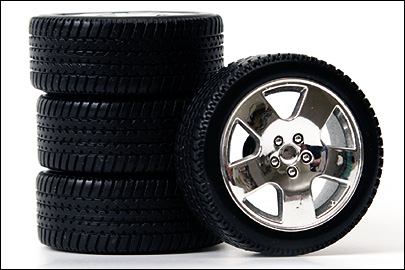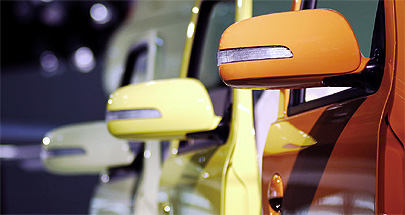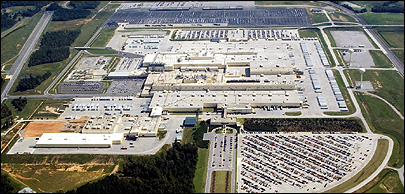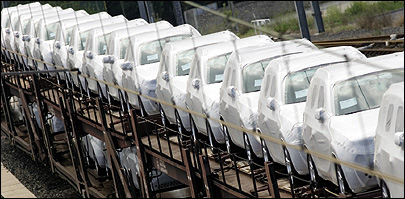Feb 01, 2007In the past few years, epic changes in the automobile industry have put increasing pressures on the Big Three U.S. automakers—the Chrysler Group, Ford Motor Co. and General Motors—and many European auto manufacturers also struggling to remain competitive. Gas prices have soared, sparking demand for hybrid vehicles and shrinking the market for sport-utility vehicles. At the same time, competition from low-cost Asian manufacturers has intensified. Car manufacturers also have had to cope with new government regulations, requiring the tracking of parts for recall and recycling.
In addition, the auto-industry supply chain is growing more complex. More than 64 million vehicles were manufactured in 2005, requiring up to 10,000 parts each, in assembly plants around the world that take up as much acreage as the average neighborhood. After assembly, tens of thousands of vehicles are stored in massive yards and then shipped over land, sea and rail to distribution centers, where they are customized with sunroofs, leather upholstery and other accessories before being transported to dealerships.
Many of the world's largest auto manufacturers are turning to radio frequency identification technology as one way to cut costs and squeeze out profits. They're testing or deploying closed-loop RFID applications to track parts within their own supply chains, replenish workstations, move closer to a just-in-time inventory and better track completed cars. Meanwhile, automakers in Asia—primarily Japan, but to a lesser extent South Korea, China and India—are using growing profit margins to fund investment in new technologies, including RFID, while positioning themselves to make gains in the lucrative North American and European markets.
The automotive industry was one of the earliest adopters of RFID. Industry stalwarts such as Ford and General Motors were using RFID in the 1980s to track vehicles through the assembly process. When rfid journal examined the auto industry in 2004, RFID technology was also starting to help automakers gain more visibility into their inventory, make vehicle customization more efficient and accurate, and help manufacturers locate specific cars or trucks in distribution lots.
The technology has helped cut costs, analysts say, and that is why many manufacturers are extending their RFID tests and implementations to other closed-loop applications. The auto industry could further increase efficiencies and cut costs by instituting open-loop RFID tracking to reduce the amount of parts inventory needed at assembly plants, automate the receipt of supplies, prevent counterfeiting and theft, and improve the ability to pinpoint vehicles involved in recalls due to faulty parts. But so far, the industry has been reluctant to commit to tracking parts between partners in the supply chain, because some parts suppliers are in a precarious economic situation and can't take on the additional burden of tagging parts, and auto manufacturers that are being forced to restructure don't have the funds to invest in new IT infrastructure.
Still, spending in automotive manufacturing RFID applications is expected to grow from $200 million in 2006 to $662 million in 2011, according to ABI Research. And a consortium of auto-industry associations from Asia, Europe and North America has joined together under the guise of the Joint Automotive Industry (JAI) to promote a global dialogue on RFID issues.
Most of the top 10 automakers worldwide now deploy some type of closed-loop RFID system at their facilities to track parts shipments within their own supply chains and replenish parts on the assembly line. Analysts say that technology alone is unlikely to be a "magic bullet" that will increase the market share for automakers overnight, but it can help companies cut costs and make their vehicles more price-competitive.
In November, Nissan North America, a subsidiary of Tokyo-based Motor Co., became the latest automaker to implement an active RFID real-time locating system (RTLS) from WhereNet to track inbound auto parts and outbound completed vehicles at the company's 4-million-square-foot assembly plant in Canton, Miss. The plant was built in 2003 with the capacity to produce 400,000 vehicles a year. Nissan expects to use the technology to reduce labor costs for vehicle processing, limit on-site time for parts and vehicles, and enhance quality by ensuring that no steps in the process are missed and that no vehicles with known defects get shipped.
"Think of an automobile plant as a little city that employs 5,000 people," says Gary Latham, automotive solutions director of industry marketing and business development for WhereNet. "It has trucks and trailers coming in and out all the time. Each vehicle has 2,500 suppliers for its more than 10,000 parts. You need to bring it together all at one time to make a red XYZ car. In order to coordinate multiple things in this big place, you need to have automation with systems constantly monitoring the physical location of supplies."
Ford has several WhereNet RFID applications under way to track deliveries in the yard and replenish parts on the production line at plants throughout North America and Europe. The company has been able to use an RFID-based system to order parts from the assembly line when needed, eliminating the need for estimated shipments and reducing the amount of inventory kept on hand. At the same time, worker safety in the company's plants has improved because parts are no longer stacked high at workstations or impeding the movement of workers.
"A big driver of this whole process has been to reduce inventory, improve workstation safety and develop the availability of pull systems for supplies so they bring parts in smaller quantities only when I need them," says Ted Thuis, Ford's business process specialist for materials, planning and logistics. He says Ford is striving to reduce costs by moving to a just-in-time inventory in the hopes that streamlining processes will help increase the company's profit margin.
Some automakers are using passive tags to automate the replenishment of parts to the assembly line. In 2006, DaimlerChrysler's production plant near Stuttgart, Germany, added passive UHF inlays to existing kanban parts-management cards. The project seeks to use RFID to improve the flow of parts from an onsite storage depot to workstations on the production line. A kanban is a just-in-time manufacturing management system in which physical cards printed with text identify parts and the workstations where the parts are used. The RFID-enabled cards automatically fulfill orders when workers transfer them from storage bins to the parts depot.
Another form of asset tracking that has become widespread in the auto industry is the use of active RFID tags to keep tabs on new vehicles, which often get misplaced; when that happens, the only way to identify them is to have workers read the vehicle identification number (VIN) on the vehicles.
The reusable RFID tags, which typically are hung from the automobile's rearview mirror, communicate each vehicle's location to a central data system that coordinates the tag with the VIN. BMWs and Land Rovers are routinely tracked as they leave factories in Europe. The Broekman Group, an auto distributor, has a subsidiary in Rotterdam that employs RFID to pinpoint the location of any of the 40,000 vehicles delivered by ship and housed in outdoor lots, parking garages and processing centers. At Volkswagen's Autostadt (Auto-City) facility in Wolfsburg, Germany, more than 10,000 cars are tracked with RFID tags and displayed in 48-meter-high glass towers for public view, purchase and delivery.
After vehicles leave the assembly plant, they are often transported to distribution centers (DCs), where they may be customized before being sent to dealerships. In the past, a sticker with information about which accessories needed to be added would be posted on the windshield, and workers would need to read that information and determine where to send each vehicle. IBM has been working with a large DC in the United States to automate the process with RFID technology to save on labor, make sure the right vehicles get the right detailing and reduce the time that a vehicle spends at the DC. That, in turn, reduces the distributor's liability for theft and damage, as well as overhead associated with the vehicle.
International auto dealers need to make sure that the right aftermarket parts are available at DCs close to the dealership where a customer ultimately purchases a car. RFID can help manufacturers track shipments of parts overseas. In 2006, Unipart Group, a third-party logistics provider, started testing active RFID on containers of aftermarket Jaguar automobile parts as they were shipped from the United Kingdom to the United States.
RFID also helps distributors track finished automobiles. "This reduces days of inventory, which can be substantial when you think of the thousands of cars that you're holding for 20 days or more," says Gus Gaeta, a partner with IBM Global Business Service. "If you're able to reduce that by five days, it's substantial. It lowers your risk of theft, damage, carrying costs. That's the big advantage."
In the wake of the Firestone recall of tires on Ford Explorers in 2000, the U.S. Congress passed the Transportation, Recall, Enhancement, Accountability and Documentation (TREAD) Act. The act, which said nothing about RFID, mandated that carmakers track tires from 2004 onward so they can be more easily recalled in the event of a problem. But tire manufacturers, led by Michelin, organized to get the auto industry to agree to RFID standards for tires out of fear that Ford might push one standard, Toyota another and Wal-Mart yet another. That tire standard remains one of the few auto industry RFID standards to date.
Yet tire manufacturers haven't flooded the market with tagged tires. One of the sticking points is that current tags can't store all the data required to comply with the TREAD Act. Automakers have to correlate the tire's Department of Transportation (DOT) number with a car's VIN. But this data would require more than the 96-bit user-programmable memory available on most UHF chips manufactured today. "We're so advanced that we aren't being serviced right now by chip manufacturers," says Pat King, global electronic strategist for Group Michelin. The company says that there should be two Gen 2 passive RFID tags—one 96-bit tag and one with 1,000 or 2,000 bits of memory on top of the 96 bits.

Tire makers could use RFID tags with Electronic Product Code numbers that correlate to information in a database, which they are required to keep under the TREAD Act. Michelin has no immediate plans to use RFID to track consumer tires because, King says, the company sees no way to recoup the return on investment involved in instituting such an RFID tagging program.
Car manufacturers are also looking at RFID to comply with new European Commission laws mandating that 80 percent of each car be recycled. Italian automaker Fiat is testing an RFID system in which tags are applied to certain car components; the tags communicate the wear and tear of those components to an onboard centralized computer. If a car must be scrapped, the owner and/or dealer could use the data to determine which components still have available life and would be good candidates for recycling or resale.
The pilot is part of a project called PROMISE—Product Lifecycle Management and Information Tracking Using Smart Embedded Systems—involving 22 organizations around the world, including Fiat. The automaker is currently tagging alternators on certain models. "Little by little, the carmakers have discovered they may make a profit from the secondhand market for components," says Dimitris Kiritsis, who is coordinating the pilot and is a staff member at the Laboratory for Computer-Aided Design and Production at the Swiss Federal Institute of Technology in Lausanne.
Most automotive manufacturers aren't attempting RFID pilots or implementations involving suppliers and/or distributors, primarily because of the precarious financial position of the industry. But some automakers are realizing that they may be able to gain efficiencies by contracting with individual suppliers to track certain parts.
Honda of the UK Manufacturing Ltd. (HUM) announced plans in October to use RFID to track auto components from suppliers' facilities throughout Europe to HUM's manufacturing plant in Swindon, England. The company has started placing EPC Gen 2 tags on 250,000 reusable containers and 100,000 metal cages used by HUM's suppliers to transport components to the Honda plant. The tags, which were designed to work in environments involving large volumes of metal, will be read at portals and by handheld interrogators when shipments leave a supplier and that information will be shared electronically with HUM. Honda is not requiring suppliers to tag goods yet, but it is reading tagged containers and cages upon arrival and departure at the HUM plant, replacing the need to generate labels for each shipment.

"The key benefit is the genuine ability to remove a lot of paperwork from the supply chain," says Andy Chadbourne, a spokesperson for Intellident, which is providing Honda with the RFID tags and software. The tracking will also help Honda account for the containers and cages, which are expensive to replace, and ensure that they are returned to the right supplier. In addition, tracking containers will provide visibility into the supply chain and help Honda move to a just-in-time inventory.
In spring 2007, the Automotive Industry Action Group (AIAG), an international standards group, is expected to detail guidelines on an industrywide RFID initiative to track returnable or reusable containers that move auto supplies up and down the supply chain. This should help automakers save some of the $673 million they spend every year on racks, totes and containers, made of metal, wood and plastic, to move auto parts—from windshields and doors to steering wheels and brake systems. Right now, these reusable assets are often lost or misplaced—and sometimes they're even shipped back to the wrong supplier. The Asia-Pacific division of CHEP, a pallet and reusable-container rental company, has added RFID-tagged injection-molded crates for the Australian automotive industry to its growing arsenal of containers.
The auto industry also could use RFID to fight counterfeiters by verifying the authenticity of parts. Collision automotive- part makers have joined together under the auspices of the Manufacturers' Qualification and Validation Program, a Michigan-based organization set up five years ago at the urging of the insurance industry, to add RFID to its electronic supply-chain tracking system. The system helps enable collision automotive-part makers to run a virtual pedigree system to provide tracing and certification for replacement parts after a vehicle has been in an accident.
Before such an open-tracking system could be established, the auto industry would need to set up a uniform numbering system for parts. EPCglobal has been eager to get more auto industry input in order to encourage a numbering system for parts sold both at retail and directly to manufacturers, but the auto industry has been resistant, partly because companies don't want to have to build a new data structure in the supply chain, the JAI says.

The JAI is taking a global approach to exploring open RFID applications for the auto industry, but has not urged member companies to embrace the EPC numbering standards to track parts or shipments of parts in cartons, totes, racks or other containers. The JAI includes the AIAG, Japan Automobile Manufacturers Association, Japan Automotive Parts Industries Association, Odette International (a European association) and Standards for Technology in Automotive Retail (a nonprofit, organization that has as its members manufacturers, dealers and retail-systems providers from around the world).
At the RFID Journal LIVE! Europe 2006 conference in November, Roya Ulrich, who is responsible for a group that is drafting DaimlerChrysler's RFID policy and strategy, told the crowd that one major stumbling block to deploying the technology throughout her company's supply chain is a lack of agreement regarding which industry standards to use to provide a common understanding of processes and a clear specification of data structures on RFID tags.
Sue Hutchinson, EPCglobal's director of industry adoption, believes it will be a while before the automotive industry reaches the next level in RFID implementation. Eventually, she says, when the industry does want to track parts shipments throughout the supply chain, it will not be through mandates: "I think it will become part of the contracting language, from the automotive manufacturer to suppliers."
One turning point may come when auto suppliers have to provide RFID-tagged goods in crossover markets—such as tires or brake systems to Wal-Mart, the U.S. Department of Defense or the aerospace industry—and they decide to embrace RFID throughout their own supply chain. "Sooner or later," says Hutchinson, "we're going to hit a tipping point where it just makes better economic sense for them to institutionalize RFID than do it selectively for different contracts."
Illustration by Susan LeVan.



